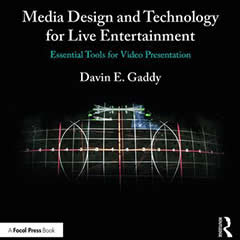Please feel free to contribute in any way!
Microphone
A transducer that changes audio energy (sound pressure) into electrical energy suitable for transmission, modification via electrical circuits and reproduction via another transducer (speakers).
Microphone Types
Dynamic
A type of microphone named after its energy conversion. Dynamic microphones typically use a diaphragm to capture the sound pressure and then modify an magnetic field to create differences of current in an electrical circuit.
Condenser
A type of microphone named after its energy conversion. Condenser microphones act like a capacitor, as sound pressure acts on the diaphragm it changes the capacitance of the capsule which creates an electrical signal.
Ribbon
A type of microphone named after its energy conversion. Ribbon microphones use a thin piece of conductive film, typically aluminum, placed between two poles of a magnet. An electrical current is created from the movement of this piece of foil.
Microphone Patterns
Cardioid
These mics have good rear rejection but worse side to side rejection compared to hypercardioid and supercardioid mics. Each of the lines represents a reduction in volume depending on where you are in relation to the mic.

Super/Hyper Cardioid
These mics have good side rejection but worse rear rejection compared to cardioid mics. Each of the lines represents a reduction in volume depending on where you are in relation to the mic.

Omnidirectional
These mics theoretically do not have rejection nodes like the various other mics have. Because of this their response is theoretically a perfect sphere in three dimensions. Each of the lines represents a reduction in volume depending on where you are in relation to the mic.

Figure-8
These mics, also known as bi-directional mics, are sensitive to sound on the front and back of the element. Because of how the element is placed, sound coming from the sides is canceled out. This is because the distance between the front and back of the element is the same causing no change in force on the element. This is illustrated in the diagram.

Shotgun
Shotgun mics are very directional microphones. Their pattern changes depending on the frequency of the sound. At lower frequency they act similarly to a hypercardioid microphone, but as the frequency increases the pattern stretches out and becomes much more directional. This is illustrated in the diagram.

Boundry / PZM
PZM stands for pressure zone microphones. These microphones use a boundary to reduce phase interference from reflections. By placing the microphone directly on the floor, instead of placing a microphone above the floor on a stand, the reflection of the sound off the floor is removed. This greatly reduces interference.
An introduction into the most common mics and their uses
Dynamic Instrument Mics
AKG D112: cardioid dynamic mic
This microphone is also a very popular kick drum microphone. It has a much more classic tone than the Shure Beta52. It is also commonly used to mic up bass cabinets and acoustic basses.
Audix D2/D4: cardioid dynamic mic
These are very common and durable tom mics. They can take a beating and sound good while doing it.
Electrovoice RE20: cardioid dynamic mic
This microphone is the broadcast microphone. It is found in radio studios across the world. It excels at providing even frequency response. It also is not affected by the proximity effect. It is commonly found on acoustic basses, kick drums, baritone sax, and other instruments that have a large frequency range.
Sennheiser E604/E904: cardioid dynamic mic with built in clip
These are great sounding tom microphones. The E904 microphone are particularly durable. The integrated clamp mount make mounting on toms easy.
Sennheiser E609/E906: supercardioid dynamic mic
This is one of the most common guitar cab microphones. The two models have different sounds, many people prefer the E906 version because of the EQ switches, but are both excellent mics to keep around.
Sennheiser MD421: cardioid dynamic mic
This mic is commonly used to mic toms, bass cabinets, and horns. It is a good sounding versatile mic but has one of the worst clips in the industry. They are fragile.
Shure Beta 52: cardioid dynamic mic with built in clip
This microphone is the most popular and widely used kick drum mic on the planet. It also works on bass cabinets.
Shure SM57: cardioid dynamic mic
This is the workhorse ultimate instrument microphone. It has done just about everything, from vocals, to toms, to strings, to horns. It may not be the best sounding microphone, but it is one of the most versatile. Every kit should have a few of these in it.
Condenser Instrument Mics
AKG C451B: cardioid small diaphragm condenser mic
This is a great sounding small diaphragm condenser mic. It is commonly used as hihat mic, woodwind mics, strings, and percussion. They are very versatile mics and sound great with most things.
AKG C414: multi pattern large diaphragm condenser mic
These are workhorse large diaphragm condenser mics. The various patterns, filters, and attenuation switches make this a very versatile mics. You will commonly find it micing pianos, as drum overheads, in the percussion section, mcing mallet instruments, and choirs.
Shure SM81: cardioid small diaphragm condenser mic
These are the ultimate workhorse microphone. They are durable, everyone has used them, and they sound good. They very well known mics. It is commonly used as hihat mic, woodwind mics, strings, and percussion.
Neumann KM184/KM84: cardioid small diaphragm condenser mic
These are some of the best sounding small diaphragm condenser mics made. They are commonly used where you would pute an AKG C451 or Shure SM81.
Dynamic Handheld Mics
Audix OM5/OM7: hypercardioid dynamic mics
These microphones are essential for louder stages. They provide excellent isolation and gain before feedback. These microphones are unforgiving and require the vocalist to be right up on the mic.
Sennheiser E835 / E845 / E935 / E945: dynamic mic
The E835 and E935 version of this mic are cardioid and the E845 and E945 versions are supercardioid. They are good sounding microphones, many people prefer them over the basic Shure SM58. The E9** series are more durable and sound better.
Shure SM58: cardioid dynamic mic
This is the world's most recognizable and used microphone. Many performers call specifically for this microphone. This is a very durable mic, and can take a lot of abuse, and still work just the same. Every kit should have a few of these in it.
Condenser Handheld Mics
Neumann KMS105: supercardioid condenser mic
This is one of the premiere handheld condenser mics. It sound great, is durable, and expensive! They can be beat on vocals that require extreme clarity and precision.
Sennheiser E865 / E965: condenser mic
The E865 is a supercardioid mic and the E965 is a switchable cardioid / supercardioid mic. They both are excellent sounding handheld condenser microphones.
Shure Beta87A / Beta87C / SM86: condenser mic
The Beta87a is the supercardioid version and the Beta87C is the cardioid version of the beta mic. The SM86 is a similar cardioid condenser mic from Shure. All of these mics are very common mics. The SM86 version is often preferred because of its lack of a harsh presence peak.
Shure KSM9: Switchable cardioid / supercardioid condenser mic
Like the Neumann, this is a very popular high end handheld condenser mic. It is used in many of the same conditions.
Lavalier Mics
DPA 4060: omni lavalier mic
This is one of the best sounding lavalier mics made but are expensive. Also, to be used with Sennheiser and Shure wireless products, expensive adapters must be purchased.
Countryman B3: omni lavalier mic
These are often considered workhorse lavalier mics. They are durable, cheap, and sound pretty good.
Countryman B6: omni lavalier mic
These are the smallest lavalier mic available. They sound good, but without upgrading to the thicker cable are fragile. They are commonly used when the mic needs to be completely hidden.
Countryman E6: omni earset mic
These are well known earset mics that are commonly used for speakers and talking heads. They sound good and are easy to use. Generally building your own earset rig is preferred in a theatrical environment. They do have multiple points of failure that can make them difficult to maintain.
Microphone Madness MM-PSM-L / MM-PSM: omni lavalier mic / omni earset mic
These are a new entry into the lavalier / earset mic market. They are a cheap option that sounds good and work well.
Sennheiser MKE1 / MKE2: omni lavalier mic
These are both great sounding lavalier mics that are commonly used in TV and film but also used in theatre. The MKE1 version is smaller than the MKE2.
Miscellaneous Mics
Crown PCC-160: phase coherent cardioid condenser mic
These are the most common floor mics out there. They sound good, are low profile, and have good gain before feedback.
Microphone
A transducer that changes audio energy (sound pressure) into electrical energy suitable for transmission, modification via electrical circuits and reproduction via another transducer (speakers).
Microphone Types
Dynamic
A type of microphone named after its energy conversion. Dynamic microphones typically use a diaphragm to capture the sound pressure and then modify an magnetic field to create differences of current in an electrical circuit.
Condenser
A type of microphone named after its energy conversion. Condenser microphones act like a capacitor, as sound pressure acts on the diaphragm it changes the capacitance of the capsule which creates an electrical signal.
Ribbon
A type of microphone named after its energy conversion. Ribbon microphones use a thin piece of conductive film, typically aluminum, placed between two poles of a magnet. An electrical current is created from the movement of this piece of foil.
Microphone Patterns
Cardioid
These mics have good rear rejection but worse side to side rejection compared to hypercardioid and supercardioid mics. Each of the lines represents a reduction in volume depending on where you are in relation to the mic.
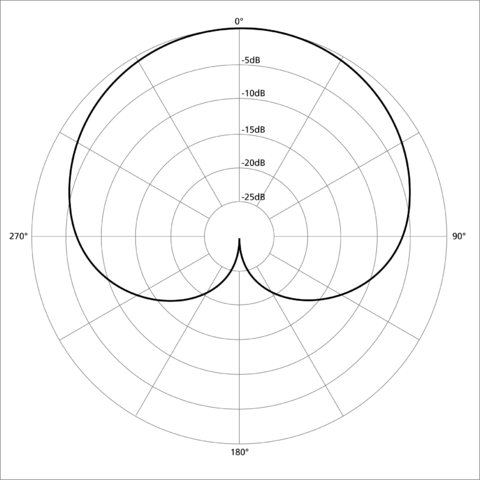
Super/Hyper Cardioid
These mics have good side rejection but worse rear rejection compared to cardioid mics. Each of the lines represents a reduction in volume depending on where you are in relation to the mic.
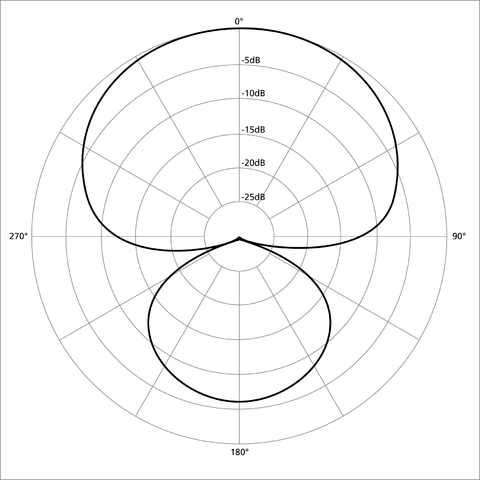
Omnidirectional
These mics theoretically do not have rejection nodes like the various other mics have. Because of this their response is theoretically a perfect sphere in three dimensions. Each of the lines represents a reduction in volume depending on where you are in relation to the mic.
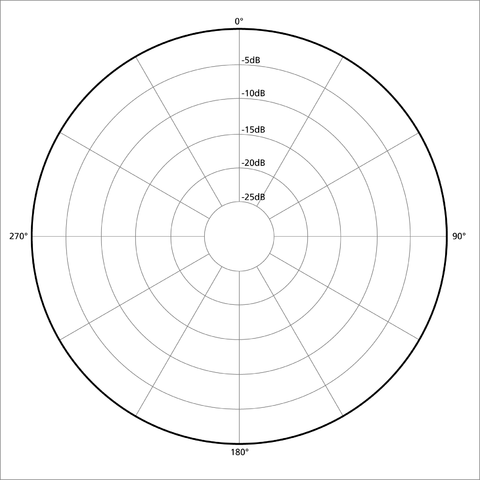
Figure-8
These mics, also known as bi-directional mics, are sensitive to sound on the front and back of the element. Because of how the element is placed, sound coming from the sides is canceled out. This is because the distance between the front and back of the element is the same causing no change in force on the element. This is illustrated in the diagram.
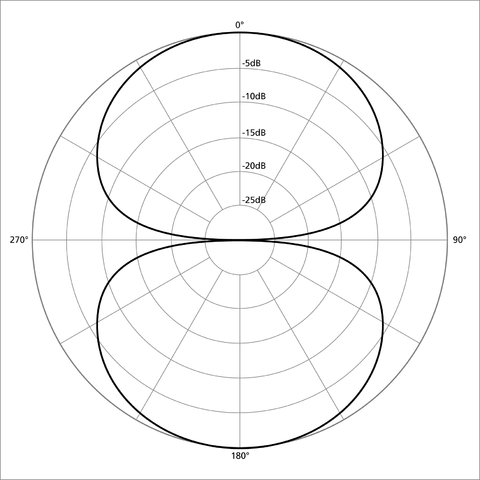
Shotgun
Shotgun mics are very directional microphones. Their pattern changes depending on the frequency of the sound. At lower frequency they act similarly to a hypercardioid microphone, but as the frequency increases the pattern stretches out and becomes much more directional. This is illustrated in the diagram.
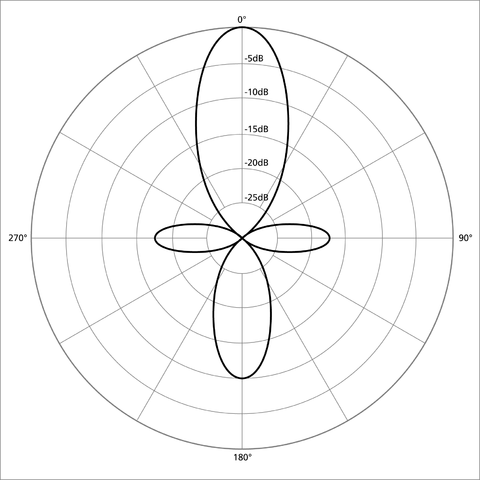
Boundry / PZM
PZM stands for pressure zone microphones. These microphones use a boundary to reduce phase interference from reflections. By placing the microphone directly on the floor, instead of placing a microphone above the floor on a stand, the reflection of the sound off the floor is removed. This greatly reduces interference.
An introduction into the most common mics and their uses
Dynamic Instrument Mics
AKG D112: cardioid dynamic mic
This microphone is also a very popular kick drum microphone. It has a much more classic tone than the Shure Beta52. It is also commonly used to mic up bass cabinets and acoustic basses.
Audix D2/D4: cardioid dynamic mic
These are very common and durable tom mics. They can take a beating and sound good while doing it.
Electrovoice RE20: cardioid dynamic mic
This microphone is the broadcast microphone. It is found in radio studios across the world. It excels at providing even frequency response. It also is not affected by the proximity effect. It is commonly found on acoustic basses, kick drums, baritone sax, and other instruments that have a large frequency range.
Sennheiser E604/E904: cardioid dynamic mic with built in clip
These are great sounding tom microphones. The E904 microphone are particularly durable. The integrated clamp mount make mounting on toms easy.
Sennheiser E609/E906: supercardioid dynamic mic
This is one of the most common guitar cab microphones. The two models have different sounds, many people prefer the E906 version because of the EQ switches, but are both excellent mics to keep around.
Sennheiser MD421: cardioid dynamic mic
This mic is commonly used to mic toms, bass cabinets, and horns. It is a good sounding versatile mic but has one of the worst clips in the industry. They are fragile.
Shure Beta 52: cardioid dynamic mic with built in clip
This microphone is the most popular and widely used kick drum mic on the planet. It also works on bass cabinets.
Shure SM57: cardioid dynamic mic
This is the workhorse ultimate instrument microphone. It has done just about everything, from vocals, to toms, to strings, to horns. It may not be the best sounding microphone, but it is one of the most versatile. Every kit should have a few of these in it.
Condenser Instrument Mics
AKG C451B: cardioid small diaphragm condenser mic
This is a great sounding small diaphragm condenser mic. It is commonly used as hihat mic, woodwind mics, strings, and percussion. They are very versatile mics and sound great with most things.
AKG C414: multi pattern large diaphragm condenser mic
These are workhorse large diaphragm condenser mics. The various patterns, filters, and attenuation switches make this a very versatile mics. You will commonly find it micing pianos, as drum overheads, in the percussion section, mcing mallet instruments, and choirs.
Shure SM81: cardioid small diaphragm condenser mic
These are the ultimate workhorse microphone. They are durable, everyone has used them, and they sound good. They very well known mics. It is commonly used as hihat mic, woodwind mics, strings, and percussion.
Neumann KM184/KM84: cardioid small diaphragm condenser mic
These are some of the best sounding small diaphragm condenser mics made. They are commonly used where you would pute an AKG C451 or Shure SM81.
Dynamic Handheld Mics
Audix OM5/OM7: hypercardioid dynamic mics
These microphones are essential for louder stages. They provide excellent isolation and gain before feedback. These microphones are unforgiving and require the vocalist to be right up on the mic.
Sennheiser E835 / E845 / E935 / E945: dynamic mic
The E835 and E935 version of this mic are cardioid and the E845 and E945 versions are supercardioid. They are good sounding microphones, many people prefer them over the basic Shure SM58. The E9** series are more durable and sound better.
Shure SM58: cardioid dynamic mic
This is the world's most recognizable and used microphone. Many performers call specifically for this microphone. This is a very durable mic, and can take a lot of abuse, and still work just the same. Every kit should have a few of these in it.
Condenser Handheld Mics
Neumann KMS105: supercardioid condenser mic
This is one of the premiere handheld condenser mics. It sound great, is durable, and expensive! They can be beat on vocals that require extreme clarity and precision.
Sennheiser E865 / E965: condenser mic
The E865 is a supercardioid mic and the E965 is a switchable cardioid / supercardioid mic. They both are excellent sounding handheld condenser microphones.
Shure Beta87A / Beta87C / SM86: condenser mic
The Beta87a is the supercardioid version and the Beta87C is the cardioid version of the beta mic. The SM86 is a similar cardioid condenser mic from Shure. All of these mics are very common mics. The SM86 version is often preferred because of its lack of a harsh presence peak.
Shure KSM9: Switchable cardioid / supercardioid condenser mic
Like the Neumann, this is a very popular high end handheld condenser mic. It is used in many of the same conditions.
Lavalier Mics
DPA 4060: omni lavalier mic
This is one of the best sounding lavalier mics made but are expensive. Also, to be used with Sennheiser and Shure wireless products, expensive adapters must be purchased.
Countryman B3: omni lavalier mic
These are often considered workhorse lavalier mics. They are durable, cheap, and sound pretty good.
Countryman B6: omni lavalier mic
These are the smallest lavalier mic available. They sound good, but without upgrading to the thicker cable are fragile. They are commonly used when the mic needs to be completely hidden.
Countryman E6: omni earset mic
These are well known earset mics that are commonly used for speakers and talking heads. They sound good and are easy to use. Generally building your own earset rig is preferred in a theatrical environment. They do have multiple points of failure that can make them difficult to maintain.
Microphone Madness MM-PSM-L / MM-PSM: omni lavalier mic / omni earset mic
These are a new entry into the lavalier / earset mic market. They are a cheap option that sounds good and work well.
Sennheiser MKE1 / MKE2: omni lavalier mic
These are both great sounding lavalier mics that are commonly used in TV and film but also used in theatre. The MKE1 version is smaller than the MKE2.
Miscellaneous Mics
Crown PCC-160: phase coherent cardioid condenser mic
These are the most common floor mics out there. They sound good, are low profile, and have good gain before feedback.
This page has been seen 1,115 times.
-
-
Created by onLast updated by on
-







